Reinforced Concrete Column Footing Design Project Report
VerifiedAdded on 2022/11/01
|7
|857
|114
Project
AI Summary
This project focuses on the design of a reinforced concrete footing foundation to support four steel columns. The report details the design process, including soil bearing capacity, loading calculations, and material specifications (concrete grade, steel ratio). It covers axial force calculations, and the determination of footing dimensions. The project also outlines the construction tasks, from site preparation and excavation to formwork and curing. The report includes an estimation of project costs, considering material and labor expenses, and emphasizes the importance of proper documentation and references. The report addresses environmental considerations related to construction materials and methods, and it incorporates relevant geotechnical and hydrological data. This project provides a practical application of structural engineering principles for civil engineering students.
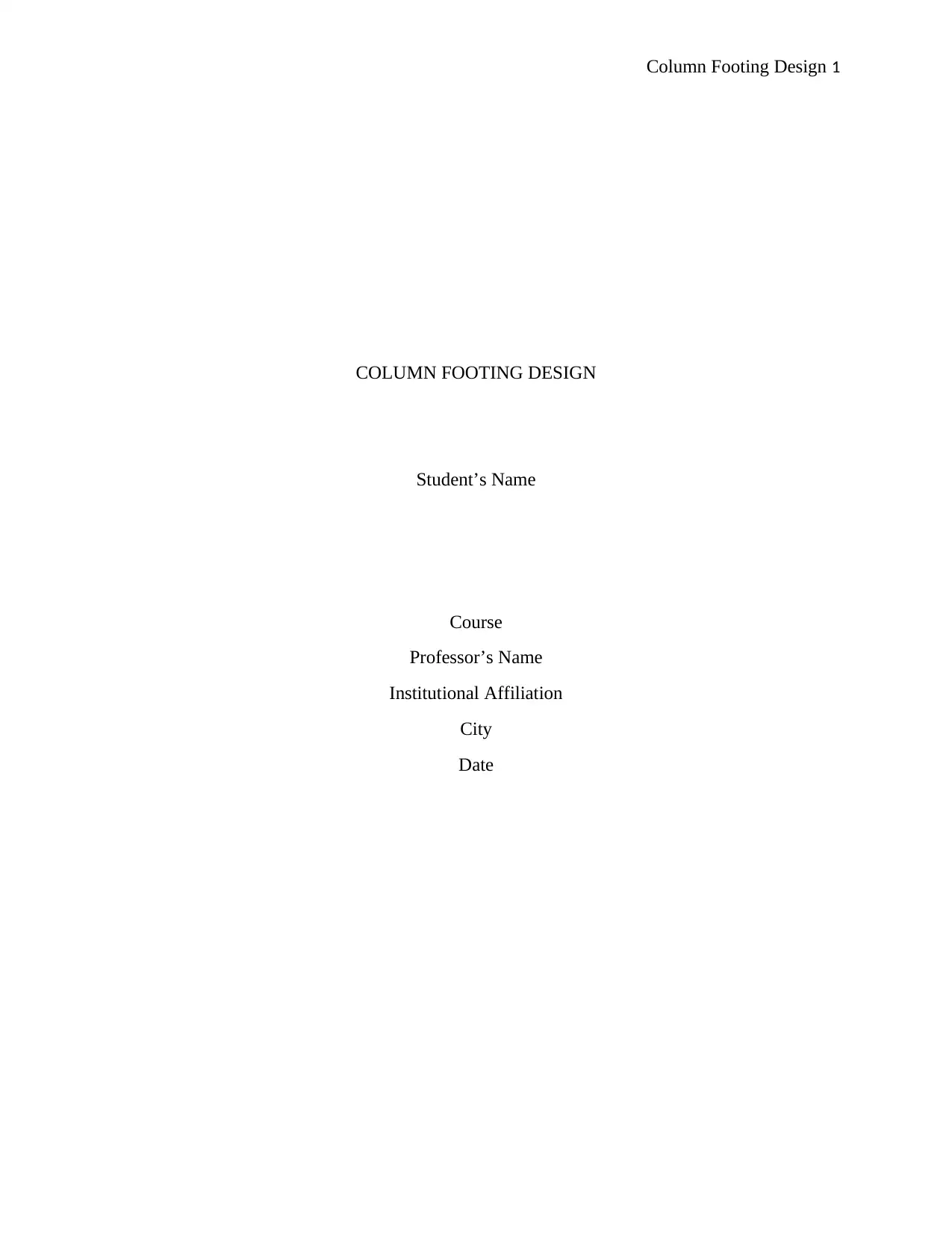
Column Footing Design 1
COLUMN FOOTING DESIGN
Student’s Name
Course
Professor’s Name
Institutional Affiliation
City
Date
COLUMN FOOTING DESIGN
Student’s Name
Course
Professor’s Name
Institutional Affiliation
City
Date
Paraphrase This Document
Need a fresh take? Get an instant paraphrase of this document with our AI Paraphraser
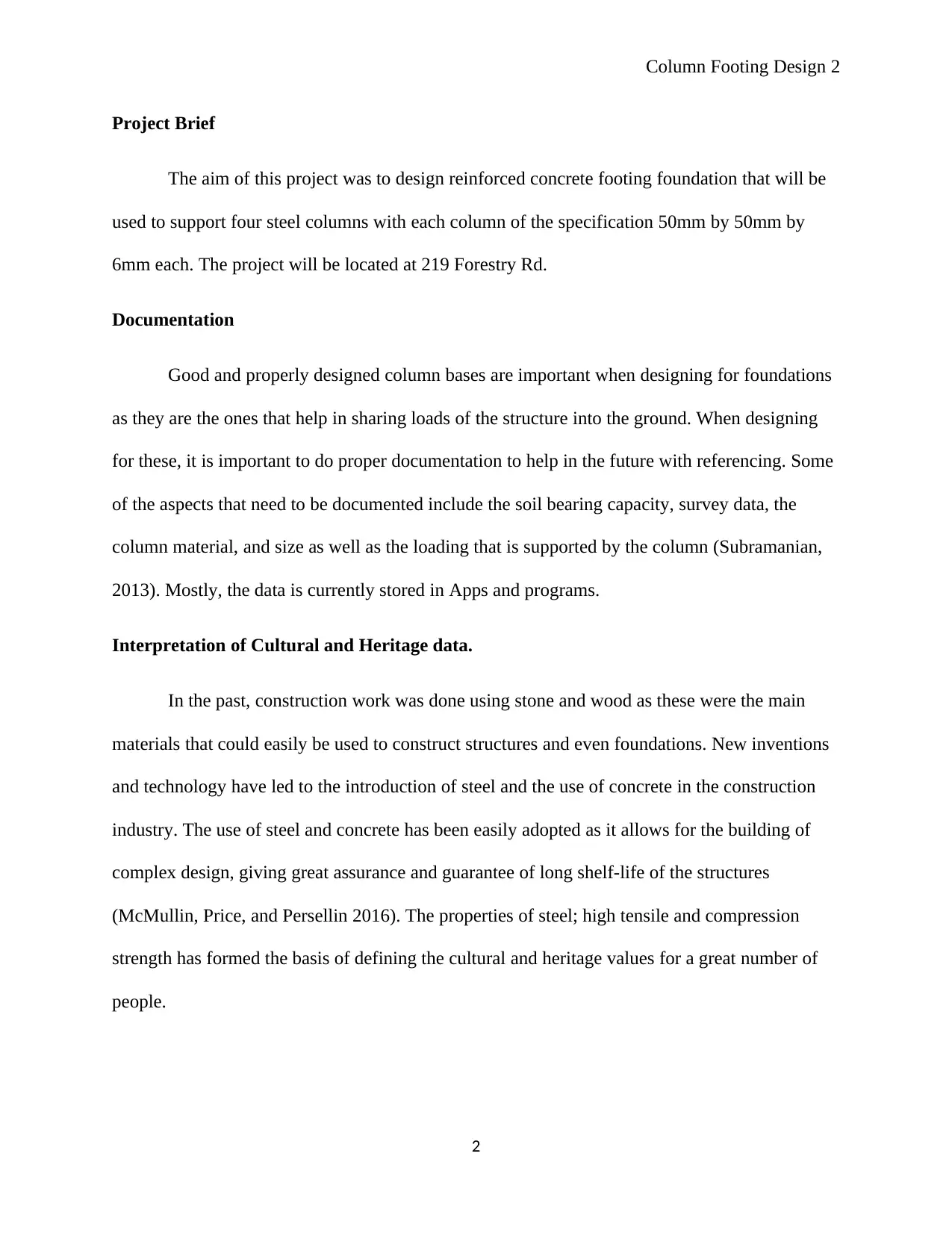
Column Footing Design 2
Project Brief
The aim of this project was to design reinforced concrete footing foundation that will be
used to support four steel columns with each column of the specification 50mm by 50mm by
6mm each. The project will be located at 219 Forestry Rd.
Documentation
Good and properly designed column bases are important when designing for foundations
as they are the ones that help in sharing loads of the structure into the ground. When designing
for these, it is important to do proper documentation to help in the future with referencing. Some
of the aspects that need to be documented include the soil bearing capacity, survey data, the
column material, and size as well as the loading that is supported by the column (Subramanian,
2013). Mostly, the data is currently stored in Apps and programs.
Interpretation of Cultural and Heritage data.
In the past, construction work was done using stone and wood as these were the main
materials that could easily be used to construct structures and even foundations. New inventions
and technology have led to the introduction of steel and the use of concrete in the construction
industry. The use of steel and concrete has been easily adopted as it allows for the building of
complex design, giving great assurance and guarantee of long shelf-life of the structures
(McMullin, Price, and Persellin 2016). The properties of steel; high tensile and compression
strength has formed the basis of defining the cultural and heritage values for a great number of
people.
2
Project Brief
The aim of this project was to design reinforced concrete footing foundation that will be
used to support four steel columns with each column of the specification 50mm by 50mm by
6mm each. The project will be located at 219 Forestry Rd.
Documentation
Good and properly designed column bases are important when designing for foundations
as they are the ones that help in sharing loads of the structure into the ground. When designing
for these, it is important to do proper documentation to help in the future with referencing. Some
of the aspects that need to be documented include the soil bearing capacity, survey data, the
column material, and size as well as the loading that is supported by the column (Subramanian,
2013). Mostly, the data is currently stored in Apps and programs.
Interpretation of Cultural and Heritage data.
In the past, construction work was done using stone and wood as these were the main
materials that could easily be used to construct structures and even foundations. New inventions
and technology have led to the introduction of steel and the use of concrete in the construction
industry. The use of steel and concrete has been easily adopted as it allows for the building of
complex design, giving great assurance and guarantee of long shelf-life of the structures
(McMullin, Price, and Persellin 2016). The properties of steel; high tensile and compression
strength has formed the basis of defining the cultural and heritage values for a great number of
people.
2
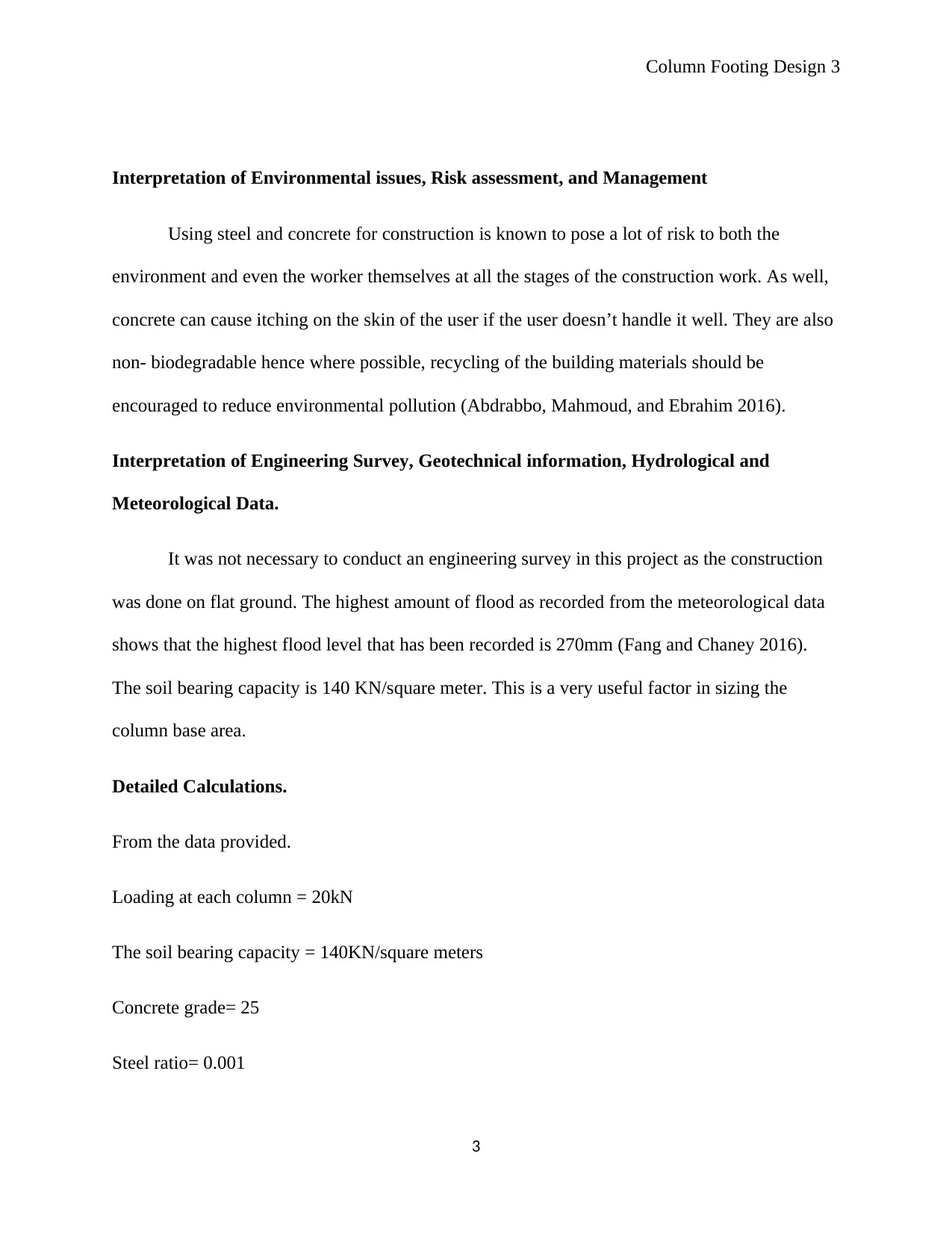
Column Footing Design 3
Interpretation of Environmental issues, Risk assessment, and Management
Using steel and concrete for construction is known to pose a lot of risk to both the
environment and even the worker themselves at all the stages of the construction work. As well,
concrete can cause itching on the skin of the user if the user doesn’t handle it well. They are also
non- biodegradable hence where possible, recycling of the building materials should be
encouraged to reduce environmental pollution (Abdrabbo, Mahmoud, and Ebrahim 2016).
Interpretation of Engineering Survey, Geotechnical information, Hydrological and
Meteorological Data.
It was not necessary to conduct an engineering survey in this project as the construction
was done on flat ground. The highest amount of flood as recorded from the meteorological data
shows that the highest flood level that has been recorded is 270mm (Fang and Chaney 2016).
The soil bearing capacity is 140 KN/square meter. This is a very useful factor in sizing the
column base area.
Detailed Calculations.
From the data provided.
Loading at each column = 20kN
The soil bearing capacity = 140KN/square meters
Concrete grade= 25
Steel ratio= 0.001
3
Interpretation of Environmental issues, Risk assessment, and Management
Using steel and concrete for construction is known to pose a lot of risk to both the
environment and even the worker themselves at all the stages of the construction work. As well,
concrete can cause itching on the skin of the user if the user doesn’t handle it well. They are also
non- biodegradable hence where possible, recycling of the building materials should be
encouraged to reduce environmental pollution (Abdrabbo, Mahmoud, and Ebrahim 2016).
Interpretation of Engineering Survey, Geotechnical information, Hydrological and
Meteorological Data.
It was not necessary to conduct an engineering survey in this project as the construction
was done on flat ground. The highest amount of flood as recorded from the meteorological data
shows that the highest flood level that has been recorded is 270mm (Fang and Chaney 2016).
The soil bearing capacity is 140 KN/square meter. This is a very useful factor in sizing the
column base area.
Detailed Calculations.
From the data provided.
Loading at each column = 20kN
The soil bearing capacity = 140KN/square meters
Concrete grade= 25
Steel ratio= 0.001
3
⊘ This is a preview!⊘
Do you want full access?
Subscribe today to unlock all pages.

Trusted by 1+ million students worldwide
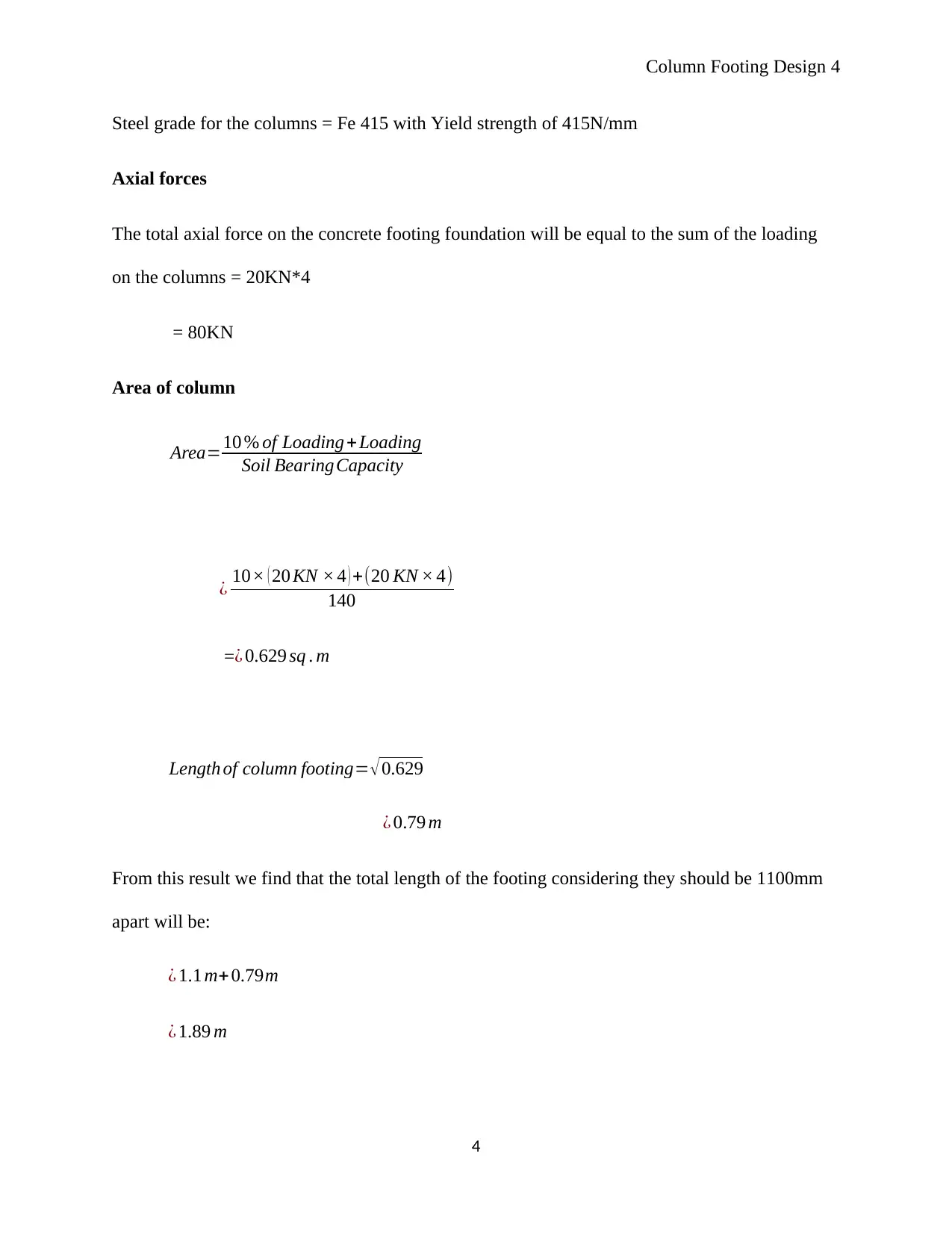
Column Footing Design 4
Steel grade for the columns = Fe 415 with Yield strength of 415N/mm
Axial forces
The total axial force on the concrete footing foundation will be equal to the sum of the loading
on the columns = 20KN*4
= 80KN
Area of column
Area=10 % of Loading + Loading
Soil BearingCapacity
¿ 10× ( 20 KN × 4 ) +(20 KN × 4)
140
=¿ 0.629 sq . m
Length of column footing= √ 0.629
¿ 0.79 m
From this result we find that the total length of the footing considering they should be 1100mm
apart will be:
¿ 1.1 m+ 0.79m
¿ 1.89 m
4
Steel grade for the columns = Fe 415 with Yield strength of 415N/mm
Axial forces
The total axial force on the concrete footing foundation will be equal to the sum of the loading
on the columns = 20KN*4
= 80KN
Area of column
Area=10 % of Loading + Loading
Soil BearingCapacity
¿ 10× ( 20 KN × 4 ) +(20 KN × 4)
140
=¿ 0.629 sq . m
Length of column footing= √ 0.629
¿ 0.79 m
From this result we find that the total length of the footing considering they should be 1100mm
apart will be:
¿ 1.1 m+ 0.79m
¿ 1.89 m
4
Paraphrase This Document
Need a fresh take? Get an instant paraphrase of this document with our AI Paraphraser
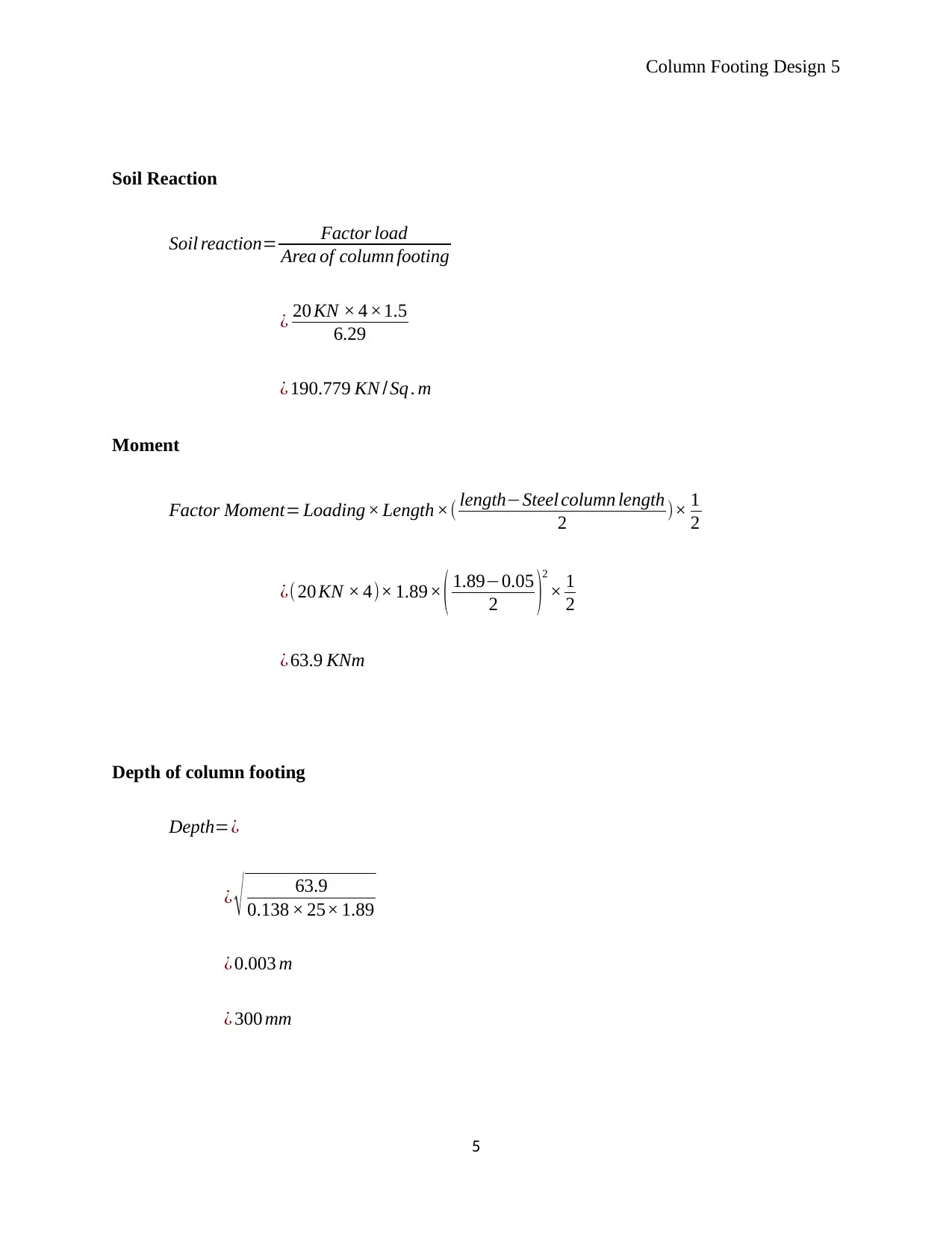
Column Footing Design 5
Soil Reaction
Soil reaction= Factor load
Area of column footing
¿ 20 KN × 4 ×1.5
6.29
¿ 190.779 KN / Sq . m
Moment
Factor Moment= Loading × Length ×( length−Steel column length
2 )× 1
2
¿( 20 KN × 4)× 1.89× ( 1.89−0.05
2 )
2
× 1
2
¿ 63.9 KNm
Depth of column footing
Depth=¿
¿ √ 63.9
0.138 × 25× 1.89
¿ 0.003 m
¿ 300 mm
5
Soil Reaction
Soil reaction= Factor load
Area of column footing
¿ 20 KN × 4 ×1.5
6.29
¿ 190.779 KN / Sq . m
Moment
Factor Moment= Loading × Length ×( length−Steel column length
2 )× 1
2
¿( 20 KN × 4)× 1.89× ( 1.89−0.05
2 )
2
× 1
2
¿ 63.9 KNm
Depth of column footing
Depth=¿
¿ √ 63.9
0.138 × 25× 1.89
¿ 0.003 m
¿ 300 mm
5
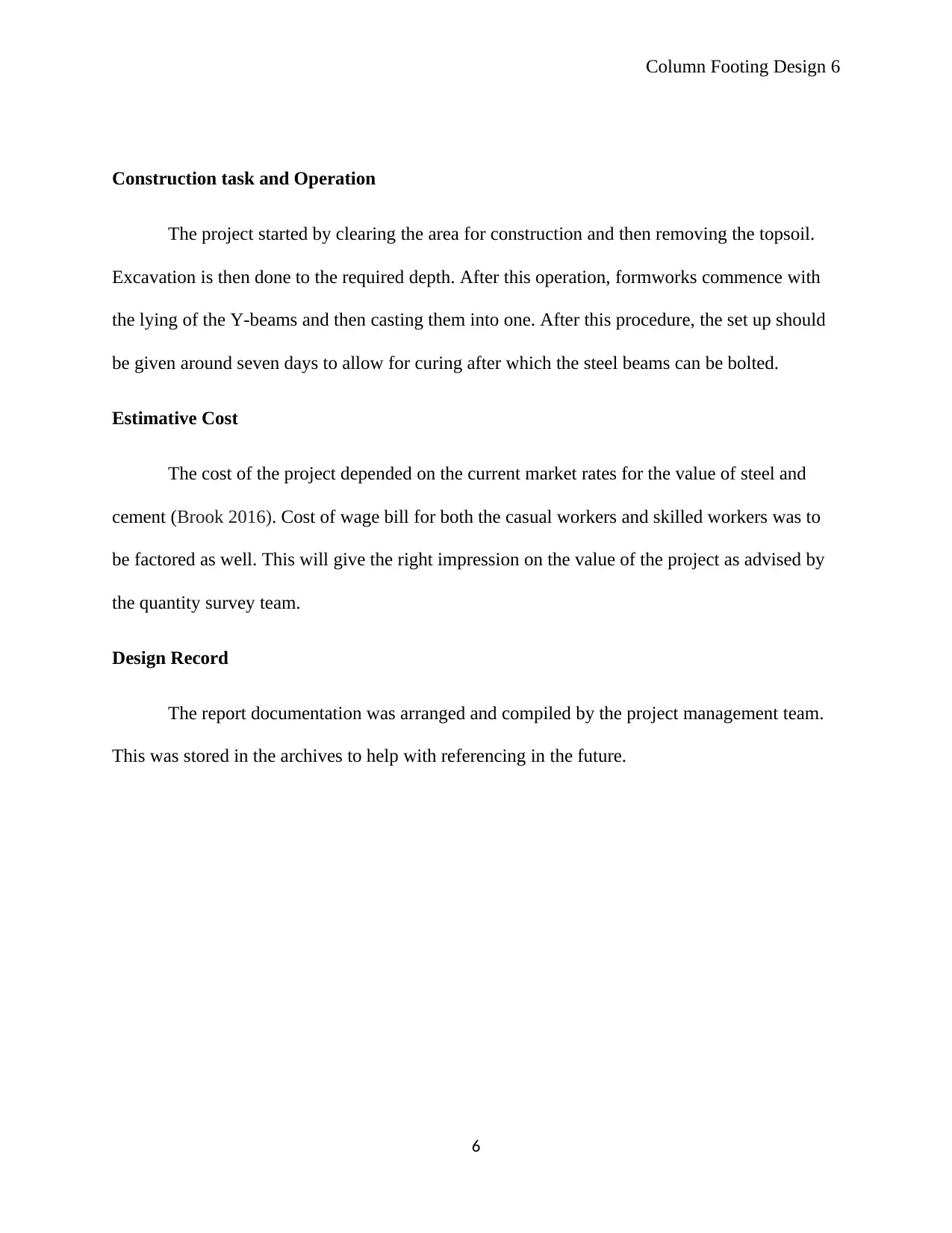
Column Footing Design 6
Construction task and Operation
The project started by clearing the area for construction and then removing the topsoil.
Excavation is then done to the required depth. After this operation, formworks commence with
the lying of the Y-beams and then casting them into one. After this procedure, the set up should
be given around seven days to allow for curing after which the steel beams can be bolted.
Estimative Cost
The cost of the project depended on the current market rates for the value of steel and
cement (Brook 2016). Cost of wage bill for both the casual workers and skilled workers was to
be factored as well. This will give the right impression on the value of the project as advised by
the quantity survey team.
Design Record
The report documentation was arranged and compiled by the project management team.
This was stored in the archives to help with referencing in the future.
6
Construction task and Operation
The project started by clearing the area for construction and then removing the topsoil.
Excavation is then done to the required depth. After this operation, formworks commence with
the lying of the Y-beams and then casting them into one. After this procedure, the set up should
be given around seven days to allow for curing after which the steel beams can be bolted.
Estimative Cost
The cost of the project depended on the current market rates for the value of steel and
cement (Brook 2016). Cost of wage bill for both the casual workers and skilled workers was to
be factored as well. This will give the right impression on the value of the project as advised by
the quantity survey team.
Design Record
The report documentation was arranged and compiled by the project management team.
This was stored in the archives to help with referencing in the future.
6
⊘ This is a preview!⊘
Do you want full access?
Subscribe today to unlock all pages.

Trusted by 1+ million students worldwide
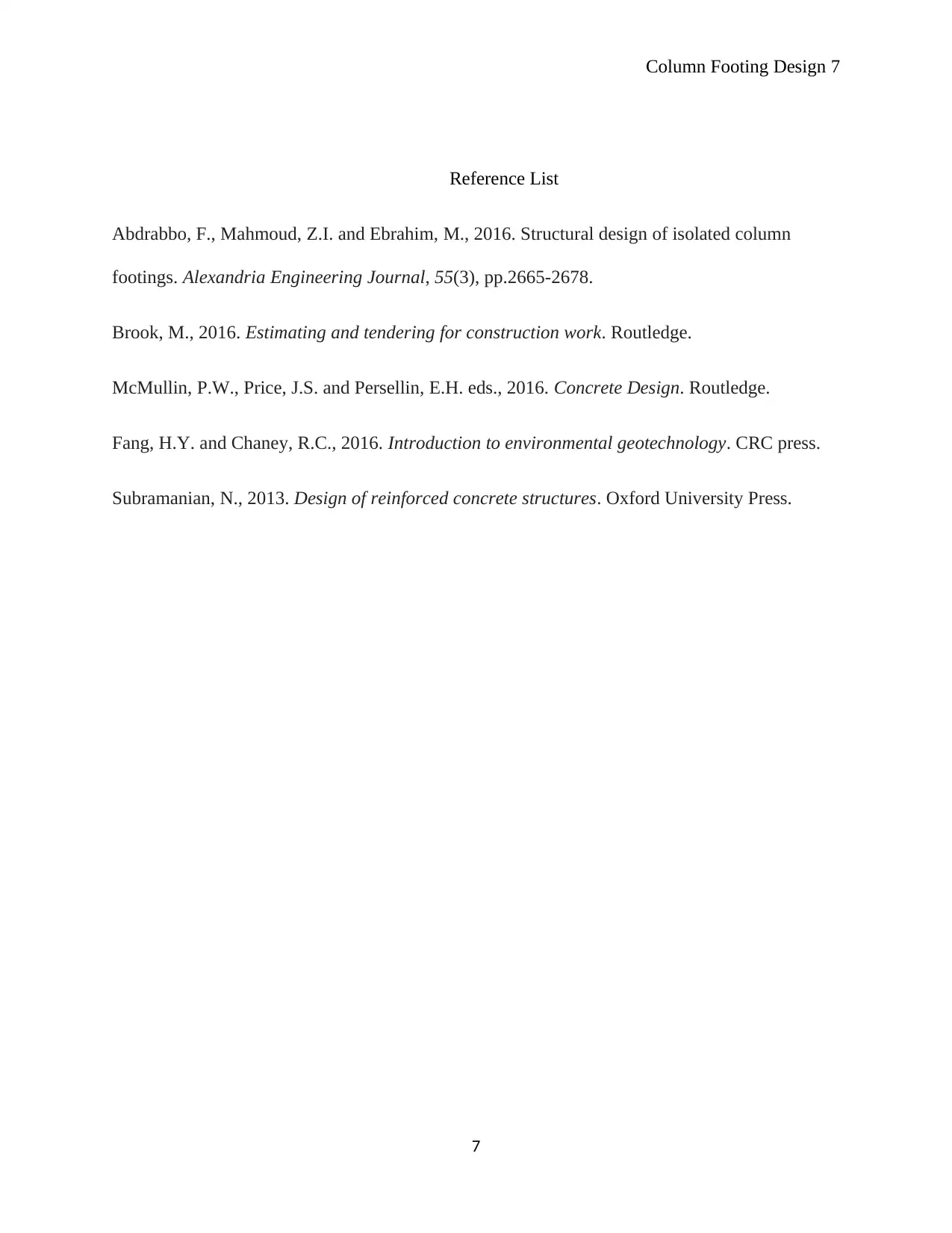
Column Footing Design 7
Reference List
Abdrabbo, F., Mahmoud, Z.I. and Ebrahim, M., 2016. Structural design of isolated column
footings. Alexandria Engineering Journal, 55(3), pp.2665-2678.
Brook, M., 2016. Estimating and tendering for construction work. Routledge.
McMullin, P.W., Price, J.S. and Persellin, E.H. eds., 2016. Concrete Design. Routledge.
Fang, H.Y. and Chaney, R.C., 2016. Introduction to environmental geotechnology. CRC press.
Subramanian, N., 2013. Design of reinforced concrete structures. Oxford University Press.
7
Reference List
Abdrabbo, F., Mahmoud, Z.I. and Ebrahim, M., 2016. Structural design of isolated column
footings. Alexandria Engineering Journal, 55(3), pp.2665-2678.
Brook, M., 2016. Estimating and tendering for construction work. Routledge.
McMullin, P.W., Price, J.S. and Persellin, E.H. eds., 2016. Concrete Design. Routledge.
Fang, H.Y. and Chaney, R.C., 2016. Introduction to environmental geotechnology. CRC press.
Subramanian, N., 2013. Design of reinforced concrete structures. Oxford University Press.
7
1 out of 7
Related Documents
Your All-in-One AI-Powered Toolkit for Academic Success.
+13062052269
info@desklib.com
Available 24*7 on WhatsApp / Email
![[object Object]](/_next/static/media/star-bottom.7253800d.svg)
Unlock your academic potential
Copyright © 2020–2025 A2Z Services. All Rights Reserved. Developed and managed by ZUCOL.





